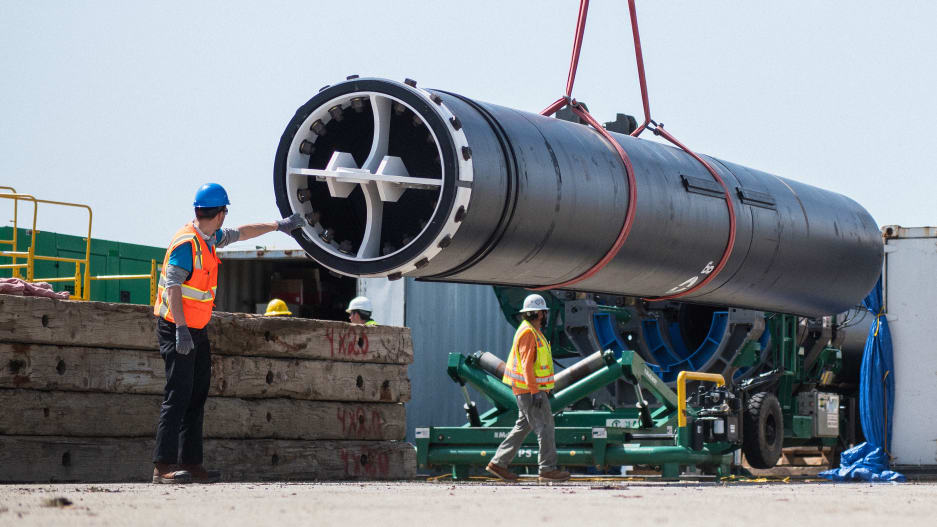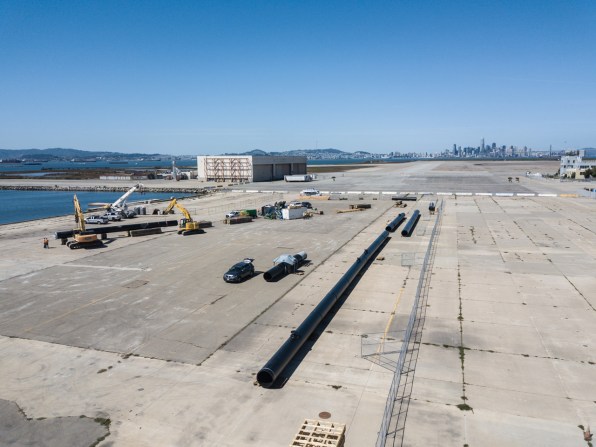The Great Pacific Garbage Patch is the largest accumulation of ocean plastic in the world and is located between Hawaii and California.
Scientists of The Ocean Cleanup Foundation have conducted the most extensive analysis ever of this area.
(The Ocean Cleanup)
Boyan Slat dropped out of school to work on his design for a device that could collect the trillions of pieces of plastic floating in the ocean.
After years of work, it’s ready to take its first voyage.
On a Wednesday afternoon in a sprawling lot on a former naval air station in Alameda, California, across the bay from San Francisco, workers are welding a massive black tube together.
The tube–roughly the length of a football field–is one piece of a larger system that will set sail for the Great Pacific Garbage Patch this summer, where it will begin collecting some of the 1.8 trillion pieces of plastic trash brought there by ocean currents.
Six years ago, the technology was only an idea presented at a TEDx talk.
Boyan Slat, the 18-year-old presenter, had learned that cleaning up the tiny particles of plastic in the ocean could take nearly 80,000 years.
Because of the volume of plastic spread through the water, and because it is constantly moving with currents, trying to chase it with nets would be a losing proposition.
Slat instead proposed using that movement as an advantage: With a barrier in the water, he argued, the swirling plastic could be collected much more quickly.
Then it could be pulled out of the water and recycled.
1.8 trillion pieces of plastic weighing 80,000 metric tons are currently afloat in an area known as the Great Pacific Garbage Patch - and it is rapidly getting worse.
These are the main conclusions of a three year mapping effort conducted by The Ocean Cleanup Research team
Some scientists have been skeptical that the idea is feasible.
But Slat, undeterred, dropped out of his first year of university to pursue the concept, and founded a nonprofit to create the technology, The Ocean Cleanup, in 2013.
The organization raised $2.2 million in a crowdfunding campaign, and other investors, including Salesforce CEO Marc Benioff, brought in millions more to fund research and development.
By the end of 2018, the nonprofit says it will bring back its first harvest of ocean plastic back from the North Pacific Gyre, along with concrete proof that the design works.
The organization expects to bring 5,000 kilograms of plastic ashore per month with its first system.
With a full fleet of systems deployed, it believes that it can collect half of the plastic trash in the Great Pacific Garbage Patch–around 40,000 metric tons–within five years.
The system uses a giant floating tube–the first one will be 2,000 feet long–made of a durable plastic called HDPE, which can float in the water, flexible enough to bend with the waves, but rigid enough to form a U-shaped barrier to stop the plastic floating on the ocean’s surface.
A strong nylon screen, attached underneath, will catch some of plastic below the surface, but because it isn’t a net, won’t catch marine life.
Large anchors, floating in still water hundreds of feet below the surface, will help steady the device so it moves in the current more slowly than the plastic, making it possible to scoop up the plastic that’s collected in front of the device.
Prototype of a section of boom tested last year. (The Ocean Cleanup)
There have been multiple engineering challenges along the way.
The design originally called for an anchor attached to the seabed, but because of the expense and complication, the team had to abandon the plan; they eventually realized that a floating anchor could work.
“There were many times in the last few years that were really rough,” Slat, now 23, told me as we sat on a pallet surrounded by sections of the device.
The fact that there was so much at stake helped him keep going.
“I would never be able to work on a photo-sharing app or ‘internet startup XYZ,'” he says.
“I think people overestimate the risk of high-risk projects.
Personally, I think I would find it much harder to make a photo-sharing app a success–it sounds counterintuitive, because it’s much easier from an engineering perspective, but I think if you work on something that’s truly exciting and bold and complicated, then you will attract the kind of people that are really smart and talented.
People that like solving complicated problems.”
Deploying The Ocean Cleanup - Simulation in SF
In a few weeks, the first piece of the technology, the length of a football field, will be towed out of the San Francisco Bay, along the coast of the Farallon Islands, where the team will test how the system holds up to towing.
To make it to the Pacific Garbage Patch, the equipment will need to be towed for three weeks.
After the local “tow test,” the engineers will bring the first section back, and connect the rest to form a total of the 2,000 feet of piping, slightly longer than the Sears Tower is tall.
With assembly complete, they’ll take the equipment 200 miles offshore for a final test.
(Because this test is not in the “accumulation zone” for plastic, they don’t expect to collect much waste, but will check that the whole system operates correctly.) If all goes as planned, they’ll set sail for the gyre, arriving in August.
By the late fall, they plan to come back with a shipment of plastic that can be turned into products.
Manufacturers like Adidas started using ocean plastic as a material, recognizing the consumer appeal, in 2016.
Ultimately, the nonprofit wants corporations to sponsor more of the systems–with logos printed on the tubes, despite the remote locations (it’s more about the symbolism)–at the other major ocean gyres.
The money made from selling the plastic to manufacturers, who want the cachet of using ocean plastic, will theoretically fund the operation.
It’s an ambitious plan.
But Slat argues that it’s a mistake, in some cases, to start with more modest solutions and scale up.
In the case of ocean plastic, using smaller technology for collection would take too long.
“I think very often problems are so big, people approach problems from the bottom up: ‘If only I do this little bit, then hopefully there will be some sort of snowball effect that will be bigger and bigger,'” he says.
“I’m much more in favor of the top-down approach to problem-solving.
Really ask, if the problem is this big, how do you get to 100%? Then knowing what it takes to get to 100%, work your way back.
Well, what do I have to do now?”
Infographic coming from Custom Made,
helps put the growing marine debris problem in perspective.
Slat, like others working on the problem of plastic waste, recognizes that collecting existing waste is only part of the challenge.
The other, of course, is stopping the initial flow of trash into the ocean, whether it’s been dumped into the Yangtze River or fallen through a storm drain in Los Angeles.
“Cleanups play an essential role in dealing with the symptoms of ocean plastics pollution, but they do not address the causes,” says Sander Defruyt, New Plastics Economy lead for the Ellen MacArthur Foundation, an organization that works on helping create closed-loop systems for plastic.
“They cannot keep pace with the rising tide of plastic pollution.
To tackle the plastic pollution crisis, there is an urgent need to rethink the way we make, use, and reuse plastics.
This will require innovators, industry, and governments to collaborate and develop solutions that prevent plastic from becoming waste in the first place.”
The organization has persuaded several major brands and retailers to commit to 100% reusable, recyclable, or compostable packaging, and promotes solutions like compostable, marine-degradable plastic made from food and agricultural waste by the startup Full Cycle Bioplastics.
But while that work continues, the enormous amount of plastic already in the ocean–affecting wildlife and showing up in sea salt and oysters and elsewhere–needs to be addressed now.
In a study that The Ocean Cleanup recently published in Nature with researchers from several universities, the team realized that the problem at the Great Pacific Garbage Patch was 16 times larger than it initially thought, or 80,000 metric tons.
“It does further underline why it’s urgent to clean up,” says Slat.
“Most of [the plastic] is still large, which means that in the next few decades if we don’t get it out, the amount of microplastics can be tenfold or 100-fold.
It’s this problem that’s waiting out there to magnify many times unless we can take it out.”
Links :
- The Independant : World's first ocean plastic-cleaning machine set to tackle Great Pacific Garbage Patch / Why is plastic bad for the environment and how much is in the ocean?
- Science Alert : A Unique Plastic Collecting Device Is About to Take on The Great Pacific Garbage Patch
- Forbes : Scourge Of The Seas: How China Is Tackling The Ocean's Plastic ... / Five Asian Countries Dump More Plastic Into Oceans Than Anyone ... / Five Ways That Plastics Harm The Environment (And One Way They ...
- FT : Stop our oceans choking on a plastic overdose / Tackling plastic pollution needs policy and new science
- Phys : What do we do about plastics?
- The Guardian : 'Plastic is literally everywhere': the epidemic attacking Australia's oceans / 'Wake-up call': microplastics found in Great Australian Bight sediment
- GeoGarage blog : How to clean up the Oceans while making ... / The Ocean Cleanup : it could work / 'Great Pacific garbage patch' far bigger than ...



No comments:
Post a Comment